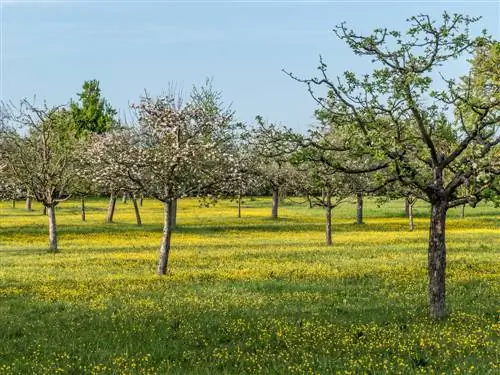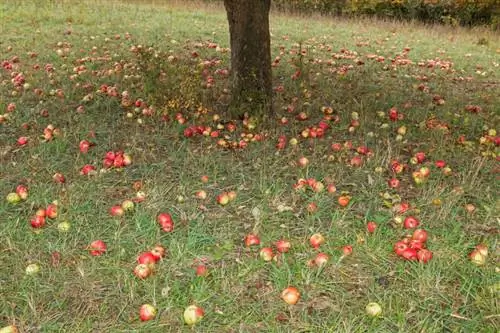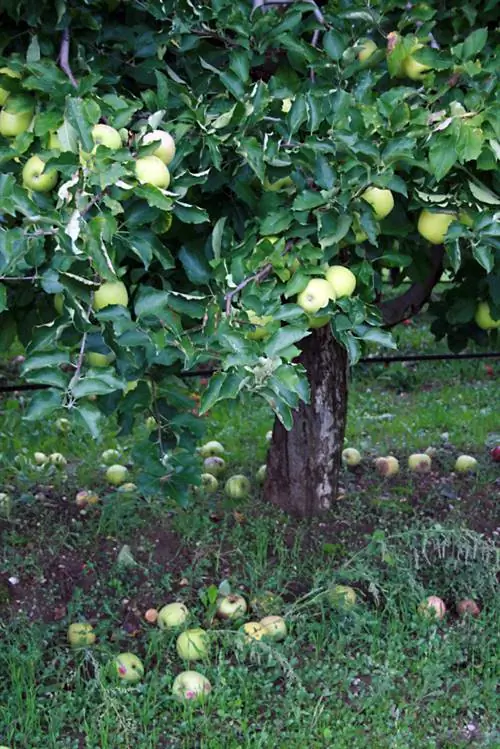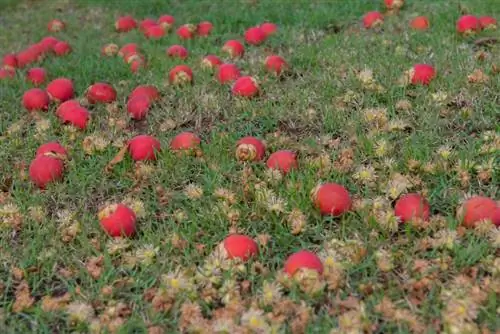- Author admin [email protected].
- Public 2023-12-16 16:46.
- Last modified 2025-06-01 06:02.
Orchards are an important part of today's cultural landscape, but due to numerous construction projects, these important habitats are increasingly being destroyed. The protection and preservation of such biotopes is therefore of great importance. There are many ways to contribute to nature conservation.
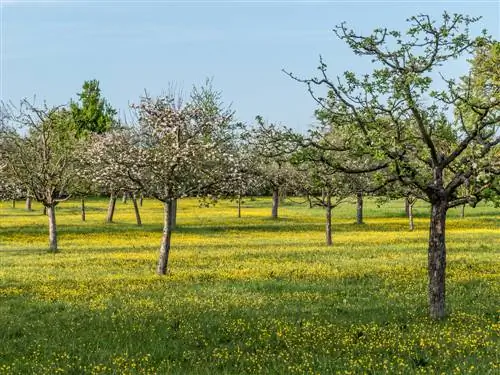
What is an orchard?
The orchard is a traditional way to grow fruit. This form of cultivation is characterized by tall fruit trees of different varieties and ages. In contrast, modern fruit growing cultures are characterized by low-stem trees. The trees benefit from sufficient space in a meadow orchard and have enough light for lush growth. Old regional varieties are typical for orchards. Therefore, these habitats represent an important source of genes for cultivated apples.
This is what characterizes a meadow orchard:
- Crown only begins at a height of 180 centimeters
- Avoid artificial fertilizers
- no use of chemical-synthetic pesticides
Orchards from a nature conservation perspective
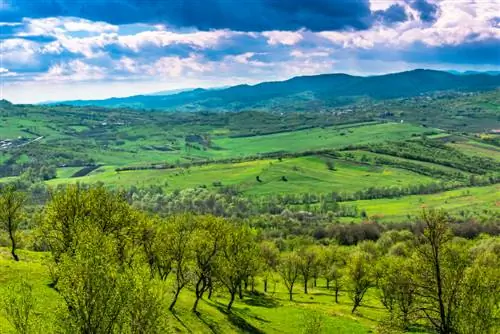
Orchards on slopes prevent soil erosion
An organic orchard offers numerous advantages. In the 18th century, orchards were a common agricultural method. They were laid out in a belt around settlements and acted as a natural windbreak. The trees are suitable for different landscape shapes. On slopes they protect the soil from erosion caused by wind and rain. They also mitigate extreme temperature fluctuations. Pasture farming can be carried out sustainably here.
| Orchard meadow | Orchard | |
|---|---|---|
| Construction | Crown layer and lush herb layer | dense crown layer |
| Harvest | laborious in several courses | efficient at a single ripening point |
| business management | unprofitable | effective |
| Number of trees per hectare | 60 to 120 | 3,000 |
| Biodiversity | high | low |

The habitats, which are sometimes called Bungert or Bitz, are also convincing from an aesthetic point of view. The different growth forms, variable flowering times and diverse colors of flowers and leaves fulfill a landscape design function.

Typical accompanying species
The herbaceous layer is dominated by grasses. But flowering meadow herbs also develop below the canopy layer when cultivated extensively. The species composition depends on the different site conditions. Biodiversity is favored by classic grazing with sheep or cattle. The sunlit trunks, which are characterized by different and natural growth forms, offer an important habitat for heat-loving insects. Birds that rely on dead wood find an ideal retreat here.
Common herbs:
- Cruciferous plants: Meadowfoam
- Umbelliferous plants: Wild carrot
- Lilies: Meadow Yellow Star
- Asteraceae: yarrow, dandelion, mugwort
- Timeless plants: Autumn timeless plants
- Lamiaceae: Medicinal Ziest, Yellow Hollow Tooth
- Roses: Great Meadow Button, Common Lady's Mantle
What you need to know about buying an orchard
Orchards are also an ideal investment for small investors with a limited budget. The annual turnover from the marketing of orchards exceeds 15 million euros. These living spaces shape part of the cultivated land in Germany. According to current estimates, there are more than 300,000 hectares of orchards in the country. But more and more property owners can no longer afford the expense of harvesting and processing and are forced to sell. If you don't want to buy land, you can think about renting it.
Price development in recent years
In recent years, the price per square meter for purchasing an orchard has continued to fall because many owners are no longer able to maintain it for various reasons. As a result, the properties become overgrown, which leads to rising costs and increased effort in reclamation.
In some regions the price for orchards with a total area of 1000 square meters is between 400 and 600 euros.
While prices around seven years ago averaged two to three euros per square meter, today the price range is between 40 and 60 cents. However, this price does not apply nationwide, but depends on the region and location. Steep properties with slopes are generally cheaper, but there are also clear differences between the individual federal states.
Current price overview and orientation
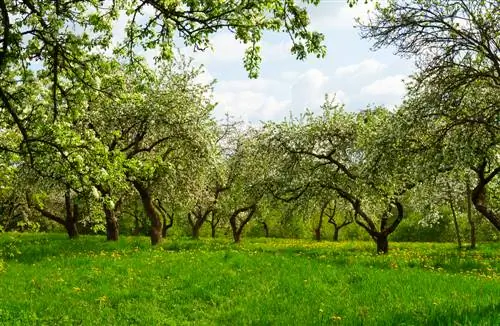
Orchards are relatively cheaply rentable areas
The land use plan provides an important clue regarding pricing. Orchards are agricultural areas. In comparison, allotments are designated weekend areas. Although these can also be converted into an ecological garden with orchards, they have a significantly higher price per square meter. Many property owners offer the land for free as a lease because they can no longer afford the effort themselves.
Example prices per square meter:
- Rhineland-Palatinate: inexpensive orchards outside designated weekend areas (under 5 euros)
- Baden-Württemberg: higher demand causes the offer price to rise (between 5-15 euros)
- Bayern: Price is influenced by condition (approx. 5-22 euros)
- Hesse: west of Frankfurt the price per square meter corresponds to the land price for arable land (around 7-9 euros)
Opportunities for financial support
In some federal states, interested parties can finance the orchard through funding. Area bonuses or agri-environmental support programs are possible. The local nature conservation authority is your first point of contact with regard to funding.
Excursus
Orchard price Baden-Württemberg
Every two years, the state government of Baden-Württemberg organizes a competition in which all orchard managers can take part. The Orchard Fruit Prize honors innovative projects for the nature-friendly and species-promoting use of grassland, which are intended to serve as role models.
Changing mottos always provide an incentive to participate. In 2019 the theme was: “Species-rich grassland - the colors of our orchards”. In addition to a project description, photo contributions are also required. The competition's prize money is 3,000 euros, which is usually awarded to three prize winners.
North Rhine-Westphalia
In NRW there is a comprehensive funding program that is linked to certain conditions. Anyone interested in financial support can obtain information from the state's Chamber of Agriculture. Care measures for fruit trees and supplementary plantings are eligible for funding. A combination with other contractual nature conservation packages within extensive grassland use is possible.
- Minimum area size of 0.15 ha
- at least ten trees on the area and a maximum of 55 trees per hectare
- maximum hectare rate per year is 1,045 euros
If old trees in need of renovation need to be repaired or replanted, there is the possibility of investment funding. Through the Rhineland Regional Association (LVR for short), you can request free planting material for new planting or to supplement existing orchards.
Hesse
If the funding requirements are met, owners of orchards in Hesse can apply for funding. These are paid for the replanting of tall fruit trees, with a possible fee of 55 euros per tree in the planting year. In the following commitment years, an amount of six euros per tree per year can be claimed. In addition, the maintenance of such habitats can be financed. Here too, the funding level is six euros per tree cared for in one year.
Saxony
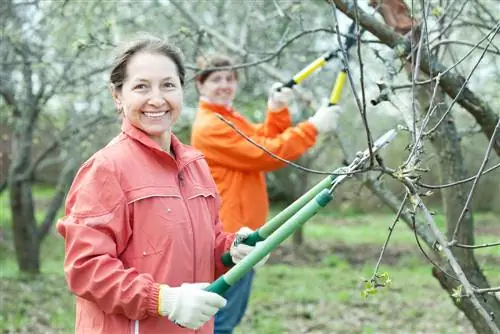
In Saxony, the care and maintenance of a meadow orchard is also eligible for funding
The conversion of arable land into an orchard as well as the care and preservation of fruit trees can be funded. If you would like to plant fruit trees, you have the option of receiving support from the Saxon State Ministry for Agriculture and the Environment. There is a fixed amount of 68 euros per tree. The prerequisite is that at least ten trees are planted in the orchard. You should plan an area of 80 to 100 square meters for each tree to be eligible for financing.
Support with woody restoration:
- with normal effort: 41 euros
- if the effort is high: 75 euros
- required technology or machines may be eligible for funding
Lower Saxony
The BUND regional association of Lower Saxony, in cooperation with the Lower Saxony BINGO Environmental Foundation, has launched a program to promote orchards. Orchards are a focus of the financing, which amounts to between 10,000 and 30,000 euros.
Bavaria
Under certain conditions, farmers are en titled to funding to maintain their orchards. The existing stock is supported with eight euros per tree per year. The upper limit is 100 trees per hectare. Strong-growing pome and stone fruit as well as nut trees that have or reach a minimum trunk height of 1.40 meters and a crown diameter of three meters are eligible for funding.
Private orchard: funding in Bavaria
- The creation of new orchards is eligible for funding from the LfL
- Up to 70 percent of the costs can be reimbursed for LNPR measures
- Total expenses must be at least 2,500 euros
How do I create an orchard?
If you want to create an orchard, a few basic requirements must be met. There are special guidelines for a meadow orchard to be accepted as such. You should expect about an hour of work per tree. So that the young trees can grow optimally, they should be protected from browsing by wild animals with wire mesh.
Important criteria:
- at least ten tall trees
- coordinated mixed stock
- variety selection tailored to the region
Selection of location
Unused long green areas usually offer ideal conditions for creating a garden with orchards. However, you should choose the location carefully to ensure ideal growth. A humus-rich and permeable clay soil in a sunny and wind-protected location is ideal, preferably on a slope but not at the foot or in a hollow.
Plan planting
Trees are ideally planted in autumn so that they can take root optimally until the next season. A planting plan not only brings structure to your project, but is also necessary for applying for funding. The varieties must be able to withstand the climate in your region. Therefore, the trees must be selected carefully. Nature conservation organizations such as NABU, LBV or BUND are the first point of contact when it comes to creating a meadow orchard.
Tip
Also include additional materials in your plan such as plant stakes, binding material, wire mesh for any windbreaks or stakes.
Trees for orchards
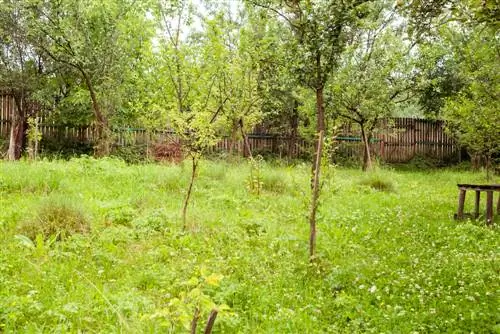
In a meadow orchard almost exclusively grafted standard trees are planted
Only refined standard trees with robust properties should be planted in an orchard. To create an organic orchard, special varieties have been developed that can adapt perfectly to the conditions. They have low demands on location and are particularly easy to care for.
In contrast, wild forms usually place high demands on the soil and only thrive in optimal climates. However, the selection of varieties is limited by the regional climate. There are more than 3,000 apple varieties in Central Europe, around 60 of which can be grown in Germany.
Important criteria:
- Varieties must be adapted to the respective location
- Consult pomologists for the correct selection of trees
- Any compensatory measures require quality assurance by specialists
Planting spacing
The distance between the trees plays an important role, because only with the right planting distance can a species-rich habitat for as many species as possible develop. The closer the varieties are planted, the less light falls on the trunk area and into the herb layer. This lack of light means that hardly any species settle here.
Orientation values:
- Pome fruit: Apple and pear trees require a distance of twelve meters
- Stone fruit: Sour cherries and plums require a planting distance of eight meters
- Wild fruit: Sparrow, crabapple or serviceberry require a distance of eight meters
If you want to encourage bees in your orchard, a dense crown is undesirable. The insects feel more comfortable in open areas. Therefore, ensure there is a planting distance of 20 meters between the trees. If the meadow is on a road, the trees must be at least three meters away from the road.
Tip
If you place the trees in a row, you should vary the distances between the trees. In this way you ensure different light and humidity conditions and increase the attractiveness of the living space.
What you need to know about care
The care of the orchard is of particular importance. Anyone who maintains this special form of farming has to invest a lot of time and a lot of energy. In the past, care measures were taken for granted. Today, due to technical progress, these are considered unprofitable and pose a number of challenges. However, harvesting and shaking machines offer innovative and efficient options for harvesting orchards.
Professional tree pruning
So that the trees do not age prematurely, they must be trimmed regularly and professionally. An annual cut is usually sufficient. Depending on the species, this can take place in autumn or winter. For bird protection reasons, tree pruning measures are not permitted during the breeding season between March and September.
Notes on the correct cut:
- Thin out the crown in the upper area to encourage shoots in the lower branches
- Cut off an old branch just behind a fresh young shoot near the trunk
- avoid excessive pruning
Mowing orchards
You can mow or mulch your orchard, although mowing is gentler. This takes place twice a year. The ideal time to mow is early morning or late evening. Particularly large areas should be worked on in several stages so that the animals can retreat to the areas that are still high. Make sure there is an interval of three to four weeks between the individual mowing dates.
Frequently asked questions
Why are orchards endangered?

Many forests were cleared to create living space
Between 1950 and 1970, large areas of public space were cleared to make room for new living space and commercial buildings. This progress was important for economic development. Although conservationists have been fighting to preserve these special habitats since the 1980s, they are still at great risk today. The need for living space is still enormous. Fences, English lawns and coniferous trees are increasingly shaping the cultivated land, which means that orchards and their biodiversity are being pushed back further and further.
Can I get involved in associations for the preservation of orchards?
There are numerous associations nationwide in which nature lovers and those interested can work to protect and preserve these species-rich habitats. This option is an ideal alternative for interested people who do not have their own orchard. The non-profit organizations offer meetings and hands-on activities not only for families with children but for anyone who would like to engage more intensively with the topic.
A selection of orchard associations
- Swabian Scattered Fruit Paradise e. V. in Bad Urach
- Streuobst e. V. in the Göttingen district
- Streuobswiesen Alliance Lower Saxony
- Freundeskreis Eberstädter Streuobstwiesen e. V.
- Lüneburger Streuobstwiesen e. V.
Are there alternative projects to support orchards?
The possibilities are almost endless. By buying products from farmers who make fruit brandies or jams from the orchards they harvest themselves, you are making an important contribution to preserving these important habitats. You have a free choice and can look for homemade food in a farm shop in your area or buy products in various online shops. The Sauerland Genussmanufaktur, for example, offers the “Sauerländer Streuobstwiese” fruit brandy. The orchard rescuer initiative in the Rhine-Neckar region offers further options.
What can you build on a meadow orchard?
Building law on orchards is regulated differently in the federal states. The basis is the respective state building regulations. Tool sheds and fencing in orchards often require approval. However, different regulations apply in a private garden than on an outdoor area. The local building authority or nature conservation authority can provide you with further information on this topic.
Orchard meadow: what is allowed?
As the owner of an orchard, you not only have rights but also obligations. Since these meadows represent a special habitat, they are subject to nature conservation. Therefore, you cannot do whatever you want on the surface. Which regulations apply depends on the respective federal state. In the Esslingen district, for example, parties with more than ten people or camping on the site require a permit.

